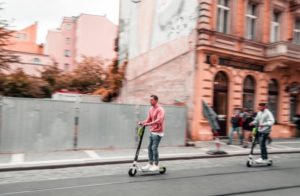Appearing On:
















Serious injuries deserve experienced attorneys
Razor Scooter Lawyers
Anyone who grew up in the 90s and 2000s will be familiar with Razor scooters. For teenagers at the turn of the 21st century, having the lightweight aluminum scooter that could fold up easily was a major status symbol. The smooth polyurethane wheels, simple foot-operated spoon brake, and foam-wrapped handlebars all combined to give a smooth ride that was great for getting around or performing tricks.
The Razor company also began manufacturing electric scooters in 2003, but they failed to gain the  same popularity as their unpowered predecessors. However, thanks to the boom in dockless vehicle-sharing now permitted in numerous American cities, Razor’s new and improved line of dockless rentable electric scooters are now appearing all over Washington, DC.
same popularity as their unpowered predecessors. However, thanks to the boom in dockless vehicle-sharing now permitted in numerous American cities, Razor’s new and improved line of dockless rentable electric scooters are now appearing all over Washington, DC.
Razor e-scooters are rented in much the same way as their competitors, but they have a few different features. The large wheels are air-pumped, intending to give a smoother ride than certain solid-wheeled competitors, and they navigate hazards more easily. The standing platform is much wider than alternatives, allowing a rider to stand with both feet together rather than having one behind another. Most significantly, however, Razor scooters boast a bicycle-like seat for riders on a raised post at the rear of the scooter.
This critical distinction may have unintended consequences for riders in Washington, DC. Most e-scooters are ridden on the sidewalk, but this not always legal. The District typically recognizes just three classes of vehicles for the purposes of where a rider can be: bicycles, motor vehicles, and Personal Mobility Devices (PMDs). Bicycle riders have the widest latitude for where they can be. If there is no bike lane present, cyclists can choose between riding on the sidewalk, following pedestrian rules, or riding on the open roadway, following the same rules as motor vehicles. If there is a bike lane, it must be used. Cohen & Cohen
Personal Mobility Devices include powered single-axis vehicles like monowheels and Segways, as well as most electric scooters and electric skateboards. These can be operated on sidewalks or in certain bike lanes. However, if a vehicle has two inline wheels (one behind the other), it is only considered a PMD if it lacks a seat. “Pedal-assist” bicycles, with electric motors that can push the bike over 20 mph, are classified along with motorcycles as motor vehicles and cannot be used on sidewalks or in bike lanes.
The large Razor electric scooters have seats, which may cause them to be classified along with motorcycles in certain circumstances or in certain parts of the District. Accordingly, riders should seek the advice of a Razor scooter lawyer to determine what their options are and how to be protected in an accident.
Personal Injury Attorneys In:
Washington DC | Maryland | Virginia
“Cohen & Cohen did a great job at recovering a good amount of money for me after my accident. Siri was super informative & responsive. Overall I had a great experience using this firm & they will be my first call if I am ever in an accident again.”
– Charles M.
 Personal Injury Accident
Personal Injury Accident
“I had a very positive experience with Cohen & Cohen and I highly recommend them to anyone who needs their services.”
– John G.
 Tractor Trailer vs Car
Tractor Trailer vs Car
“I would highly recommend Cohen & Cohen. They were awesome on my case. Cohen & Cohen had my best interest at heart at all times.”
– Morgan L.
 Personal Injury Accident
Personal Injury Accident
“My experience at Cohen & Cohen has been great from the beginning until the very end when my case was closed…I would definitely recommend them to family, friends or anyone that has a case with a personal injury accident.”
– Maria M.
Reviews
From Our Valued Clients
Cohen & Cohen has an impeccable client satisfaction rating with hundreds of 5-star reviews. We are among the best-rated firms in D.C., Virginia, and Maryland.

Best Personal Injury Lawyer in DC








Cohen & Cohen Has Been Featured On


















